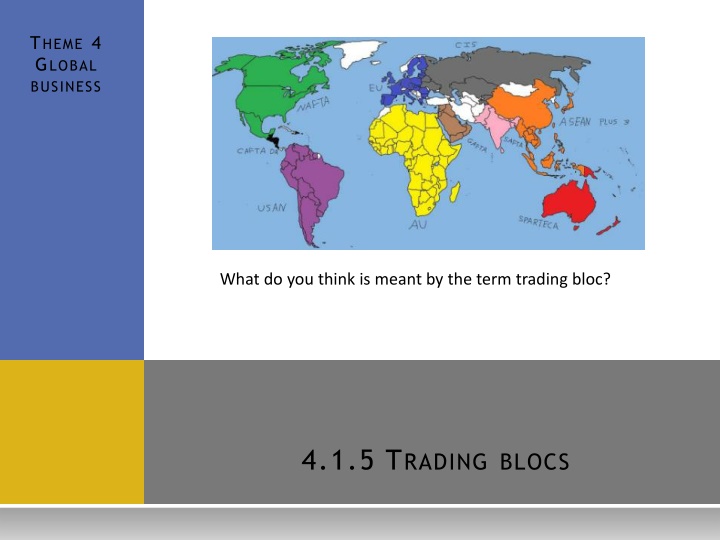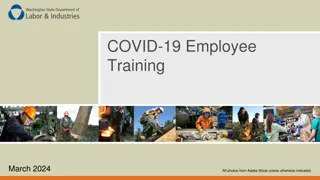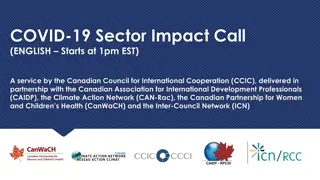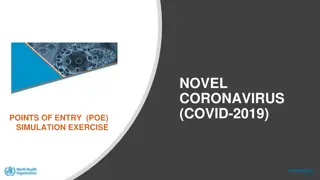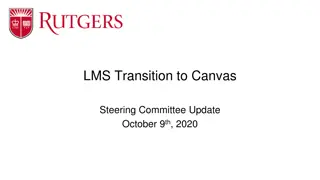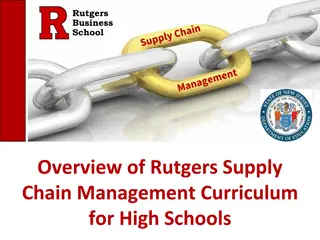Impact of COVID-19 on International Education: Insights from Rutgers
The COVID-19 pandemic has significantly affected international education, particularly at Rutgers University. This impact ranges from decreased enrollment numbers to challenges faced by international students. Despite these obstacles, Rutgers has responded with innovative programs to support academic success amidst the global crisis. Learn more about the initiatives and changes implemented to adapt to the new normal in international education.
Download Presentation

Please find below an Image/Link to download the presentation.
The content on the website is provided AS IS for your information and personal use only. It may not be sold, licensed, or shared on other websites without obtaining consent from the author.If you encounter any issues during the download, it is possible that the publisher has removed the file from their server.
You are allowed to download the files provided on this website for personal or commercial use, subject to the condition that they are used lawfully. All files are the property of their respective owners.
The content on the website is provided AS IS for your information and personal use only. It may not be sold, licensed, or shared on other websites without obtaining consent from the author.
E N D
Presentation Transcript
THEME 4 GLOBAL BUSINESS What do you think is meant by the term trading bloc? 4.1.5 TRADING BLOCS
4.1.5 TRADINGBLOCS In this topic you will learn about Expansion of trading blocs: EU and the single market ASEAN NAFTA Impact on businesses of trading blocs
TRADINGBLOCS Who do you think the LATAM gang of four are? Trading blocs are when the governments of a group of countries agree to trade together freely i.e. normally with no trade barriers The countries are normally grouped together geographically e.g. the European Union (EU) The members of a trading bloc make preferential economic, and sometimes political, arrangements to boost trade within the member states
TYPESOFTRADINGBLOCS Preferential trade areas Members agree to either reduce or eliminate trade barriers for a select number of goods or services, resulting in partial trade liberalisation Free trade areas Members agree to either reduce or eliminate trade barriers for all goods and services, resulting in trade liberalisation Customs unions Members agree to the removal of trade barriers amongst themselves and a common approach to trade barriers when dealing with countries outside of the bloc In a sense the bloc is now acting as one homogenous group
TYPESOFTRADINGBLOCS Common markets Members agree to the removal of trade barriers as well as the freedom of movement of factors of production within the bloc Often also involves the agreement of common economic policies Economic unions Comprises of the features of both a customs union and a common market, including common economic policies Trading blocs in numbers.
THE SINGLE EUROPEAN MARKET The Single market has 27 member states and is a major world trading power. As an economic force, it is larger than the USA. The UK voted to leave in 2016. Advantages Disadvantages Trade creation Trade is encouraged within member states because there are no barriers, so additional trade is created within the bloc. Trade diversion The existence of the common external tariff, diverts trade away from the EU. Goods within the SEM may be more expensive, and this could damage consumer welfare. Competition Stronger competitive forces within the SEM can drive productive and dynamic efficiency, which will benefit consumers. Monopolies In some markets e.g. gas and electricity, tariffs have seen significant merger activity and the creation of large monopolies seeking to exploit the available economies of scale. Access to markets The SEM creates a market of 28 countries and a population of over 500m, offering significant scope for businesses to expand. Unemployment In some countries, workers may lose their jobs as production is transferred to member states with lower labour costs. Freedom of movement There is the right to live and work anywhere within the SEM without restriction which boosts labour mobility. Cost Membership of the SEM costs the UK around 15b per year.
CUSTOMSUNIONS The EU is not a free trade area as such, but a customs union A free trade area is a group of countries that have removed most or all tariffs and/or quotas A customs union will involve internal free trade amongst member states, but also includes a common external tariff Each member of the customs union cannot pursue their own international trade policy, instead trade negotiations are conducted on behalf of all member states The EU is the biggest customs union in the world with a 15.5% share of world trade It is important to differentiate a customs union from the Single European Market (SEM), which in addition to having no internal trade barriers and a common external tariff, also involves the free movement of goods, services, capital and labour which promotes deeper economic integration and market liberalisation What s the difference between a single market and a free trade agreement?
EU ENLARGEMENT Since its inception in 1958, the EU has grown from 6 to 28 member states, with Croatia the most recent country to join in 2013 In 2016 the UK voted to leave the EU At the current time there are a further 5 candidate countries for EU membership i.e. Iceland, Macedonia, Montenegro, Serbia and Turkey Potential positive implications of enlargement include: EU enlargement has increased the potential for economies of scale and free trade across a larger geographical area and population For consumers, the increased competition may drive down production costs leading to lower prices and increased choice and quality For businesses, they will be able to take advantage of the relative low wages of new accession countries However, there are some potential negatives to EU enlargement, which include: Can the UK cope with the influx of migrant workers from new accession countries? New countries may require additional support from the EU, which may be partly funded by stronger nations EU enlargement may increase bureaucratic costs for all existing members In 2013 the EU restarted talks with Turkey after 3 years.
ASEAN The Association of Southeast Asian Nations (ASEAN) was founded in 1967 Its members are Brunei, Cambodia, Indonesia, Laos, Malaysia, Myanmar (Formerly Burma), the Philippines, Singapore, Thailand and Vietnam Keep abreast of developments at ASEAN. It is one of the fastest growing markets in the world and is a major producer of manufactured products, many of which are exported to the US and European countries As it grows in size it looks to rival the EU and NAFTA in terms of economic power
ASEAN If it was a single country ASEAN would be the fourth largest economy in the world What is meant by GDP per capita? At 600m it has a bigger population than both the EU and North America. With real GDP growth of over 5% over the years 2000- 2013 it looks likely to become a significant economic powerhouse It is a diverse market with rich cultural differences and differences in GDP per capita, with Singapore one of the richest countries in the world in terms of per capita income As its economy continues to grow rapidly it will be able to compete effectively with the EU and NAFTA
NAFTA The North American Free Trade Association (NAFTA) was founded in 1994 It is a trilateral agreement between the USA, Canada and Mexico Its aim is to eliminate any barriers to trade between the three countries The agreement led to significant FDI into Mexico, particularly from the USA Often, production was transferred from the USA to Mexico, creating significant tension amongst American workers However, it is clear that NAFTA has led to significant growth since its introduction How will the UK leaving the EU affect relations with NAFTA?
TRADINGBLOCS Work in pairs to complete the table below. Trading Bloc How it functions Successes and failures European Union ASEAN NAFTA Select one trading bloc and prepare a brief presentation to outline how it functions and evidence of success or failures.
THE WORLD TRADE ORGANISATION (WTO) The WTO s mission statement: Progress towards complete trade liberalisation has increased in recent years. One of the main organisations involved in this has been the World Trade Organisation. Established in 1995, its purpose is to promote free trade by persuading countries to abolish import tariffs and other barriers The WTO is the only international agency overseeing the rules of international trade It polices free trade agreements and settles trade disputes between governments and organises trade negotiations WTO decisions are absolute and every member must abide by its rulings There are currently 160 members Most Favoured Nation (MFN) status is required for all members providing trade advantages such as reduced tariffs The WTO is the international organisation whose primary purpose is to open trade for the benefit of all. WTO s $1trn deal in 2013.
CONFLICTSBETWEEN TRADINGBLOCSAND WTO The WTO seeks to reduce trade barriers in order to promote world trade. Trading blocs might conflict with the WTO because they: Distort trade by creating barriers Negatively impact on non-members Allocate resources in an inefficient manner Lead to protectionist policies between trading blocs Contravene a key requirement for WTO membership in that all members must have MFN status
IMPACTONBUSINESSESOFTRADINGBLOCS There are a large number of potential impacts, both positive and negative. Some of these include: Free trade within the bloc encouraging specialisation and trade Easier access to knowledge, workers and components Economies of scale Take advantage of favourable differences between members e.g. taxes or labour costs May reduce trade with countries outside of the bloc Not all members may have same power May damage domestic industries
4.1.5 TRADINGBLOCS In this topic you have learnt about Expansion of trading blocs: EU and the single market ASEAN NAFTA Impact on businesses of trading blocs
